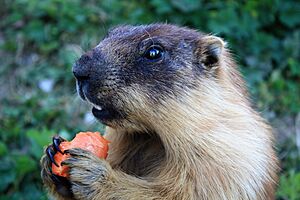Tarbagan marmot facts for kids
Quick facts for kids Tarbagan marmot |
|
|---|---|
 |
|
| Conservation status | |
| Scientific classification | |
| Genus: |
Marmota
|
| Species: |
sibirica
|
The tarbagan marmot (Marmota sibirica) is a type of rodent that belongs to the Sciuridae family. You can find these animals in parts of China, northern and western Mongolia, and Russia. Sometimes, in the Mongolian Altai Mountains, they live in the same areas as the Gray marmot. In 2008, the IUCN listed the tarbagan marmot as an endangered animal. This means their numbers are getting very low.
Scientists recognize two types, or subspecies, of the tarbagan marmot:
- M. s. sibirica
- M. s. caliginosus
Contents
What's in a Name?
The name "tarbagan" comes from the Russian word "тарбаган." This word itself comes from an older language spoken in Mongolia. It refers to certain types of rodents. The word is also connected to "targa," which means beaver in some other languages like Ulch and Nanai. People also call the tarbagan marmot the Siberian marmot or the Mongolian marmot.
Appearance and Home
The tarbagan marmot is a medium-sized marmot. Its head and body are about a quarter of its total length. In summer, its fur is short, about 11–20 mm long. But in winter, it grows thicker and longer, up to 30 mm. Their fur has two dark gray bands, then a white band. Their cheeks are yellow.
Male tarbagan marmots are usually bigger and heavier than females. Both males and females typically weigh between 6 and 8 kilograms. The tarbagan marmot is special because it's one of only two marmot species that live in lowland areas. The other one is the groundhog.
You can find these marmots mostly across Mongolia. Their home range stretches from the Altai Mountains in the west to Inner Mongolia in the east. They live as far north as Transbaikal and as far south as the Dzungarian Basin in the Gobi desert.
Hunting and Food
For hundreds of years, people in Mongolia have eaten the tarbagan marmot. It's a traditional food in Mongolian cooking. One special dish is called boodog. To make boodog, people cook the meat by putting hot stones inside the marmot's body. The skin is then tied up, and the meat cooks inside this natural "bag." People usually hunt marmots for food in the autumn. This is because the animals are heavier then, as they are getting ready for hibernation (their long winter sleep).
An explorer named Richard Maack once saw tarbagan hunting in Siberia. He wrote that hunting them was quite hard. It was tough to get close enough to shoot them. Also, these smart animals never go far from their burrows. If they weren't killed right away, they would quickly hide in their deep burrows. Then, hunters would have to dig them out, which was a lot of work.
Marmots and Health
Sometimes, tarbagan marmots can carry a serious illness called the plague. This has happened in places like northeastern China and Mongolia. The plague can spread among marmots, especially when they cough. It can also spread from marmots to humans. This might happen through the bite of a special flea that lives on marmots, or if someone eats the meat. When many marmots get sick with the plague, it can sometimes lead to people in the same area getting sick too. This is why it's very important to be careful around these animals and their meat.
Helping the Environment
The tarbagan marmot is known as an "ecosystem engineer." This means it helps create and change its environment in ways that benefit other animals. For example, their burrows create a network of safe spots. Other species can use these burrows to warm up in the sun, find food, or hide from danger. This can make the habitat better and help other animals survive. Also, tarbagan marmots are an important food source for predators like gray wolves and golden eagles.


